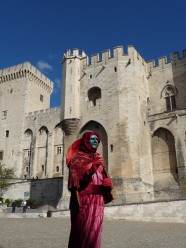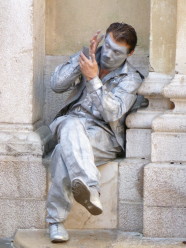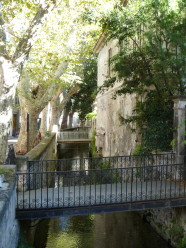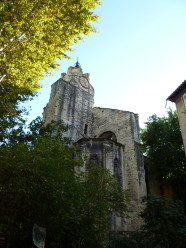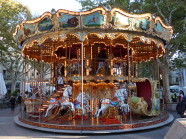 Attractively situated on the southern Rhône in France, Avignon is a walled city with spectacular medieval sights. The historic centre has many charms to offer the tourist. Today Avignon is a UNESCO world heritage site, where tourists, not 14th-century clerics, throng the narrow, winding streets and visit the grand palace of the Avignon popes.
Attractively situated on the southern Rhône in France, Avignon is a walled city with spectacular medieval sights. The historic centre has many charms to offer the tourist. Today Avignon is a UNESCO world heritage site, where tourists, not 14th-century clerics, throng the narrow, winding streets and visit the grand palace of the Avignon popes.
The towers of the palais des papes are visible for miles as you approach on the fast train, the TGV from Paris. You must enter the wall through one of the twelve gates where medieval travellers were likely to be greeted by a traitor’s rotting torso or severed leg to warn against committing treason. Today, the main artery running north to the palace is as mercantile as during the time of the popes. At the Place du Change, the hub where the seven parishes converge, the stalls still push their wares aggressively at passing shoppers. In summer, you’ll see buskers, street dancers, and an antique carousel. During the July arts festival, the city swells to twice its usual size, replicating the noise and congestion of the middle ages. Spotting a famous musician in an outrageous costume is today’s equivalent of glimpsing the Pope processing through the streets with his retinue of guards and cardinals.
The palace that visitors enter today was built by successive popes throughout the 14th century, each one enlarging and decorating according to his taste—Benedict, notably dour, and Clement VI, a lover of luxury. When you are ejected through the gift shop, you can walk along the rue du Chapeau Rouge and stop for a café express in a bar called Chez Cardinal. The medieval layout of the streets is surprisingly intact, though modern maps are an unreliable guide since the street names have changed many times over the years. In the secondhand bookshops, you can find ancient maps and arcane French books, which deal more in legend than in history.
Over the years that I was imagining and writing Muse, I visited Avignon five times to connect to the physical and emotional geography of my heroine, Solange Le Blanc. I wanted to put a human face on life in medieval Avignon. What buildings stood inside the city walls? What clothes were worn, what foods were eaten, what diseases and acts of god shortened a person’s life? I tried to understand the daily life of its citizens and courtiers. What was it like to live in the extraordinary time known as the Babylonian captivity when the popes resided there?
I explored the various quartiers and the streets occupied by the merchants and guildsmen, such as the rue des Fourbisseurs (furnishers) and the rue de l’Epicerie (spice sellers). I calculated how long it would take Solange to travel distances on foot or by horse. I located the surviving cardinals’ livrées (Ceccano’s is now the municipal library), and visited the massive churches, many of which were built in the 14th century. Like Solange, I climbed Doms Rock, walked along the top of the medieval ramparts, stood in the cold shade of buildings, and experienced the odiousness (as the poet Francesco Petrarch called it) of the city when battered by its infamous wind. The rivers and canals still flood, the mistral still howls, and local superstition still tells us that, once it starts, it will blow for 3, 6, or 9 days. In the middle ages, the Rhône was a major traffic artery used to transport goods and people. The Saint Bénezet bridge (unbroken then) led to Villeneuve across the Rhône in France. One of the most picturesque streets in Avignon is the rue des Teinturiers, which curves along the Sorgue canal with its ancient listless paddlewheels.
The tourist office gives out a map with historical walks, so that you can follow coloured markers on the pavement to connect with history. However, there is no walk for the famous lovers, Petrarch and Laura, because much of their story is apocryphal. Petrarch lived in Avignon and wrote poems to immortalize Laura and his unrequited love for her. Although Laura was real, likely the wife of Hugues de Sade (the ancestor of the infamous Marquis), there is little evidence of her, whereas Petrarch can be found in many writings both by and about him. The church of Saint Clare is their legendary meeting place, but only the choir wall is standing. The abbey of the Cordeliers, where Laura was supposedly buried, has shrunk to a tower and her bones have disappeared. Petrarch retired to Italy to live with his daughter and was buried there in solitary glory. His poems and letters reward a careful reader, since they allude to a second woman, perhaps the mother of his two children. This was the woman who seeded the idea for Solange Le Blanc, a fiction based on a few intriguing scraps of history.
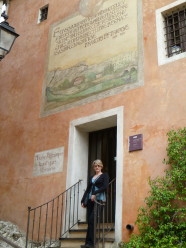 If, like Petrarch, you tire of the city and seek refuge in the Vaucluse, you can follow the Sorgue upstream along the rue des Teinturiers, and rent a car to drive the route Solange and Petrarch rode on horseback in Muse. You’ll pass past the fictional Clairefontaine abbey, tucked into the Jonquerettes area, and eventually reach the source of the Sorgue, the unimaginably deep cavern beneath the towering cliff at Fontaine-de-Vaucluse. Nearby, you’ll find what the tourist bureau calls “Petrarch’s House,” now a storehouse of memorabilia where you can spend a pleasant hour or two reimagining his life and his love for two very different women.
If, like Petrarch, you tire of the city and seek refuge in the Vaucluse, you can follow the Sorgue upstream along the rue des Teinturiers, and rent a car to drive the route Solange and Petrarch rode on horseback in Muse. You’ll pass past the fictional Clairefontaine abbey, tucked into the Jonquerettes area, and eventually reach the source of the Sorgue, the unimaginably deep cavern beneath the towering cliff at Fontaine-de-Vaucluse. Nearby, you’ll find what the tourist bureau calls “Petrarch’s House,” now a storehouse of memorabilia where you can spend a pleasant hour or two reimagining his life and his love for two very different women.
This post first appeared at the blog Good Books and a Cup of Tea

